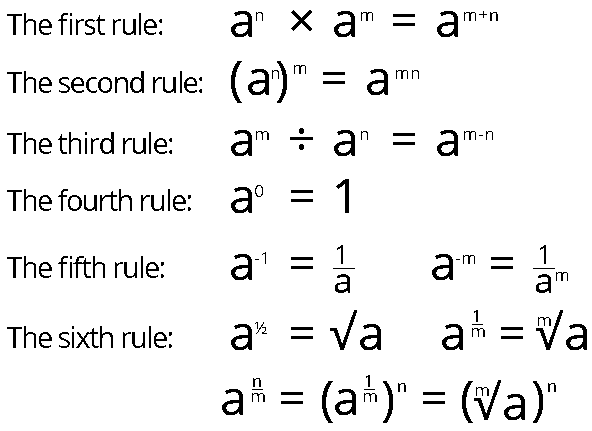With this calculator, you will easily calculate fractional exponents. In this article, we will talk about the math operation of the exponent, which can be represented in the form of a notation as bn. If you have been in doubt so far with everything that this concept brings with it, what fractional exponents are and which rules should be followed when calculating them, you can find out everything below.
Take a look other related calculators, such as:
- Phase shift calculator
- 30 60 90 triangle calculator
- 45 45 90 triangle calculator
- Power reducing formula calculator
- Probability calculator 3 events
- Cofunction calculator
- Sum and difference identities calculator
- Trigonometry calculator
- Segment addition postulate calculator
- Fundamental counting principle calculator
- Condensing logarithms calculator
- Population density calculator
What is a fractional exponent?
Fractions are a way to break down a whole number. The denominator is the number of equal parts, and the numerator is the number of parts. For example, a whole number divided by two would be a fraction with a denominator of 2 and a numerator of 1. The bottom line is that fractions are a way to show the parts of a whole.
The fractional exponent is writing down the typical expression of potencies and roots. In this case, the numerator will be power and the denominator will be root. Another name for exponents is potencies or indexes, and fractional exponents are also called radicals or rational exponents. This mode of expression is called an exponential expression and consists of two parts, the base (b) and the exponent (n). If the base is given in a fraction, it is a fractional exponent. Exponents in the form of a fraction indicate that the “power” of a number is expressed in a fraction and not in the form of an integer. We can see this in the following example:
a^{\frac{m}{n}}In this case , we have the base represented by the symbol a, while the power of the number is by m/n, which is a fractional expression. For fractional exponent expression, you can use this formula:
x^{\frac{m}{n}} = \sqrt[n]{x^{m}} = \left ( \sqrt[n]{x} \right )^{m}Here is one example:
81^{\frac{1}{2}} = \sqrt[2]{81}Negative fraction exponents
Previous examples of exponential expression were for natural numbers, and what if we have a case of a negative exponent? When it comes to negative fractional exponents, they can be observed in the same way as rational exponents, except that the difference in sign is negative in this case. To explain this situation, we need to get acquainted with the rule of negative exponent, which tells us that a number with a negative exponent should be in the denominator, or vice versa.
Here is one more example of negative fraction exponents:
x^{-\frac{3}{2}} = \frac{1}{x^{\frac{3}{2}}} = \frac{1}{\sqrt{x^{3}}}Fraction exponent rules
It is necessary to adhere to the established rules used when multiplying or dividing these numbers to make it easier to calculate with fractional exponents. Even if you are familiar with this matter and the calculation method, you may make mistakes when calculating exponents in the form of fractions. To reduce error, follow these steps:

How to solve fraction exponents?
The method of calculating and solving fraction exponents is based on a basic rule that needs to be respected:
x1/n = the n-th root of x
or
x^{\frac{1}{n}} = \sqrt[n]{x}The following example will best explain the whole process of solving these math expressions:
4^{\frac{3}{2}} = 4^{3\cdot \frac{1}{2}}=\sqrt{4^{3}} = \sqrt{64} = 8Multiplying fractions with exponents
If we need to calculate the product of two numbers with fractional exponents, it is enough to follow rule number one. Rule number one applies to numbers with the same base and different fractional exponents. In that case, it is necessary to rewrite the database and add the exponents. In practice, it looks like this:
x^{\frac{1}{3}}\cdot x^{\frac{1}{3}} = x^{\frac{1}{3}+\frac{1}{3}} = x^{\frac{2}{3}}Simplifying fractions with exponents
You have a math problem in front of you that contains numbers with fractional exponents, and you are trying to find a way to simplify the expression to find a solution easier and faster. This is possible in two ways using basic multiplication or division operations. You can do this by reducing the expression or exponent to a form that is easy to understand. So you can reduce the expression 91/2 to the number 3. The following example will explain in more detail:
You have an expression in this form:
\sqrt[3]{8} = 8^{\frac{1}{3}}Since we know that you can represent the number 8 as 8 = 23. If in this example, the number 8 is shown differently, then we can write the expression in this way:
\left ( 2^{3} \right )^{\frac{1}{3}} = 2From the new expression, we can conclude that after multiplying exponents 3 and 1/3, we get the result 1, which means that the value of this equation is equal to the number 2.
\sqrt[3]{8} = 8^{\frac{1}{3}} = 2Fraction exponent calculator – how to use?
After detailed instructions on calculating, which formulas and rules you can use, it is our turn to explain how our calculator works. We genuinely believe that this tool will efficiently and quickly calculate all the examples you come across. The calculator works on the same principle as our other calculators, where you need to enter values in the intended place. First, you need to enter the base value (x). Then fill in the spaces of the numerator (n) and denominator (d) that will be in the form of a fraction. Any denominator or numerator value you enter, negative or positive, will be shown the results in just a few seconds. Another interesting thing to note is that you can also write the base in the form of a fraction when using our calculator.
a = x^{\frac{n}{d}}